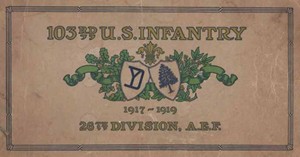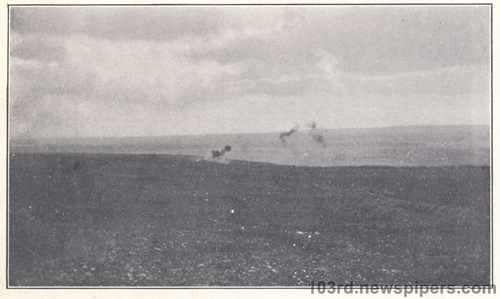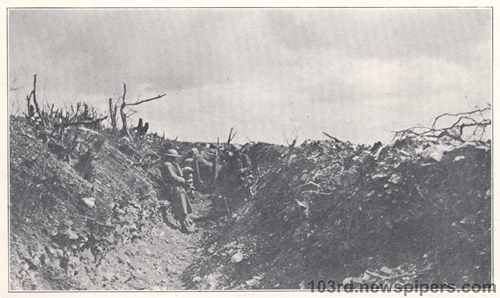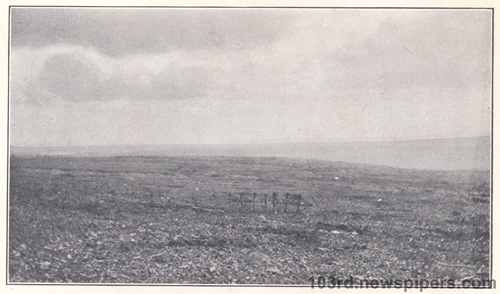
of the 26th Division of the U.S. Army
during World War I
 | The History of the 103rd Regiment of the 26th Division of the U.S. Army during World War I |
| Table of Contents | ||
 conville, Xivray; but a little farther back, at Broussey, Raulecourt, Jouy, Cor-
nieville, a few of the loravcr had remained, and they were 1nostly women.
As to the front itself, Bois Brule, at the time the 3rd Battalion took over
there, was a bad place. The enemy had just previously attacked the 104th, and
the 104th drove them back. The lines were badly weakened from the heavy
shell fire. Then, too, the rainy season which seemed never te end had made
the trenches very bad, —— deep mud and water, a scarcity of material for duclc-
hoards; all these things made the sector not a too pleasant one. But the battal-
ions took their turns at the front and did well. There were some portions of the
line which were not even uncomfortable,-—one in particular, dubbed the “()ld
Ladiesl Home," where rumor has it that certain otiicers used to go fishing to
pass the time away. ln the hack areas, support and reserve, the men had some
chance to rest, play baseball, and ether games.
Apart from the regular routine, patrolling, construction work, laying of wire,
and improving the positions, two events stand out, — the enemy gas attack on our
nien opposite Apreinont, i. 0., in the positions north of St. Agnant May 10,
1918, and the attempted wap de main (raid) against Xivray the sixteenth of
June.
On May 10 at 1.15 olclock in the morning, the enemy put over a gas attack
against the Center of Resistance, St. Agnant, by means of projectors. '1`here
was also a heavy bernbarclinent by their artillery. It will be recalled that this
attack was an absolute surprise, it being the men’s First experience with a gas-
projector attack. A word of explanation as to what a projector attack is may
not be out of place. A large number of projectors, really nothing more than
pipes or mortars of large caliber, are set in position within the enemy lines, so
ranged and elevated as to have the projectiles tired drop on the desired objec-
conville, Xivray; but a little farther back, at Broussey, Raulecourt, Jouy, Cor-
nieville, a few of the loravcr had remained, and they were 1nostly women.
As to the front itself, Bois Brule, at the time the 3rd Battalion took over
there, was a bad place. The enemy had just previously attacked the 104th, and
the 104th drove them back. The lines were badly weakened from the heavy
shell fire. Then, too, the rainy season which seemed never te end had made
the trenches very bad, —— deep mud and water, a scarcity of material for duclc-
hoards; all these things made the sector not a too pleasant one. But the battal-
ions took their turns at the front and did well. There were some portions of the
line which were not even uncomfortable,-—one in particular, dubbed the “()ld
Ladiesl Home," where rumor has it that certain otiicers used to go fishing to
pass the time away. ln the hack areas, support and reserve, the men had some
chance to rest, play baseball, and ether games.
Apart from the regular routine, patrolling, construction work, laying of wire,
and improving the positions, two events stand out, — the enemy gas attack on our
nien opposite Apreinont, i. 0., in the positions north of St. Agnant May 10,
1918, and the attempted wap de main (raid) against Xivray the sixteenth of
June.
On May 10 at 1.15 olclock in the morning, the enemy put over a gas attack
against the Center of Resistance, St. Agnant, by means of projectors. '1`here
was also a heavy bernbarclinent by their artillery. It will be recalled that this
attack was an absolute surprise, it being the men’s First experience with a gas-
projector attack. A word of explanation as to what a projector attack is may
not be out of place. A large number of projectors, really nothing more than
pipes or mortars of large caliber, are set in position within the enemy lines, so
ranged and elevated as to have the projectiles tired drop on the desired objec-
 tive. The “projector" is the term applied both to the machine for throwing
the missile as well as to the missile, which is a thin-cased container or shell
much the shape and size of an elongated football. The several—antl there
may be hu.ndreds·—1r1<»rtars are connected by electricity, so that when the
minute decided upon comes all can be discharged simultaneously. A st1·ong
concentration of gas is in the containers. The advantage of such an attack lies
in the element of surprise, for the only warning is from the tremendous flash as
the projectors are set off, and then it has arrived within five to seven seconds.
At the same time the artillery is usually very active and the combination of gas
and shell fire works havoc.
This was the sort of an attack put over the tenth of May. There were two
sets of projectors discharged, — phosgene and mustard gas were in the containers.
An idea of the density of the concentration can be gained from the fact that
grass, bushes, trees, rats, eats—-everything; alive and unprotected—were killed;
the very ground was burnt.
Companies C and D were holding the lines in front of St. Agnant; Company D
was the more severely hit, but the rear areas suffered also. St. Agnant re—
ceived a heavy bombardment with gas and high explosive. The artillery bom-
bardment accompanying the gas attack continued till daylight,
The toll was heavy — something over two hundred casualties — killed, gassed,
or wounded, which necessitated immediate relief of the troops in the line. Wvith-
out going into the details this experience was one of the worst through which
our men had to pass. Of course there were deeds of bravery and courage—
officers and men who stuck by until relieved; at one time there were six auto-
matic riiiemen holding a company front, but thc enemy did not follow up his
gas attack with an infantry attack and he was paid back three to one the next
night, for our artillery cut loose und gave him back all and more than he hadi
sent over.
The other event of importance was the attempted eneniy raid on the morning
of June 16 against Xivray-I\iarv0isin. Before going into dctuil rel:i.tivc to this
attack, I wish to insert. the following comnienilzntion of the regiment, which
succinctly statw what lmppeneml:
"Translati0n, 26111 Division, June 18, 19lS.
Vlllth Army, ll. Q. June 18, 1918.
32nd Corps,
St:1f1—3rd Bureau, Gl1}Nl£R.\L ORDERS No. 131
No. 3094
"On June 16, a strong detaelirnent, consisting of GOO picked German troops,
reinforced by Storm lintlnlion elements, ltmwlcetl nt l:1.ybreal the front line of
the 26th American Division at Xivmy mid between Xivroy and Seichprey. The
enemy wes everywhere repulsed by immediate eounter-ztttucls and left numerous
bodies on the terrain, end ten Erisoners including one ofliecr.
"This brilliant action does t e greatest honor Io the 26th American Division,
and in particular, to the 103rd Regiment, Colonel llume. _ _
“It demonsi.ru,tes the unquestiommble superiority of the American soldier over
the German soldier. It indicates elcnrly what cnn he expected from these magnifi-
cent troops when, in its turn, the Entente assumes the oifensive.
General 1’AssAoA X
Commanding the 32nd Army Corps: ,
I’AssAoA.
OFF1c1An
THE CHIEF oF STAFF
Signed E. l\IENorN."
tive. The “projector" is the term applied both to the machine for throwing
the missile as well as to the missile, which is a thin-cased container or shell
much the shape and size of an elongated football. The several—antl there
may be hu.ndreds·—1r1<»rtars are connected by electricity, so that when the
minute decided upon comes all can be discharged simultaneously. A st1·ong
concentration of gas is in the containers. The advantage of such an attack lies
in the element of surprise, for the only warning is from the tremendous flash as
the projectors are set off, and then it has arrived within five to seven seconds.
At the same time the artillery is usually very active and the combination of gas
and shell fire works havoc.
This was the sort of an attack put over the tenth of May. There were two
sets of projectors discharged, — phosgene and mustard gas were in the containers.
An idea of the density of the concentration can be gained from the fact that
grass, bushes, trees, rats, eats—-everything; alive and unprotected—were killed;
the very ground was burnt.
Companies C and D were holding the lines in front of St. Agnant; Company D
was the more severely hit, but the rear areas suffered also. St. Agnant re—
ceived a heavy bombardment with gas and high explosive. The artillery bom-
bardment accompanying the gas attack continued till daylight,
The toll was heavy — something over two hundred casualties — killed, gassed,
or wounded, which necessitated immediate relief of the troops in the line. Wvith-
out going into the details this experience was one of the worst through which
our men had to pass. Of course there were deeds of bravery and courage—
officers and men who stuck by until relieved; at one time there were six auto-
matic riiiemen holding a company front, but thc enemy did not follow up his
gas attack with an infantry attack and he was paid back three to one the next
night, for our artillery cut loose und gave him back all and more than he hadi
sent over.
The other event of importance was the attempted eneniy raid on the morning
of June 16 against Xivray-I\iarv0isin. Before going into dctuil rel:i.tivc to this
attack, I wish to insert. the following comnienilzntion of the regiment, which
succinctly statw what lmppeneml:
"Translati0n, 26111 Division, June 18, 19lS.
Vlllth Army, ll. Q. June 18, 1918.
32nd Corps,
St:1f1—3rd Bureau, Gl1}Nl£R.\L ORDERS No. 131
No. 3094
"On June 16, a strong detaelirnent, consisting of GOO picked German troops,
reinforced by Storm lintlnlion elements, ltmwlcetl nt l:1.ybreal the front line of
the 26th American Division at Xivmy mid between Xivroy and Seichprey. The
enemy wes everywhere repulsed by immediate eounter-ztttucls and left numerous
bodies on the terrain, end ten Erisoners including one ofliecr.
"This brilliant action does t e greatest honor Io the 26th American Division,
and in particular, to the 103rd Regiment, Colonel llume. _ _
“It demonsi.ru,tes the unquestiommble superiority of the American soldier over
the German soldier. It indicates elcnrly what cnn he expected from these magnifi-
cent troops when, in its turn, the Entente assumes the oifensive.
General 1’AssAoA X
Commanding the 32nd Army Corps: ,
I’AssAoA.
OFF1c1An
THE CHIEF oF STAFF
Signed E. l\IENorN."

|
||
| Original Version of Page |